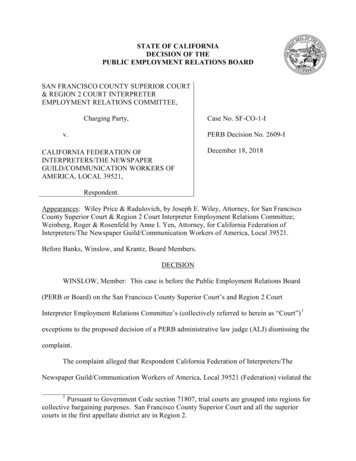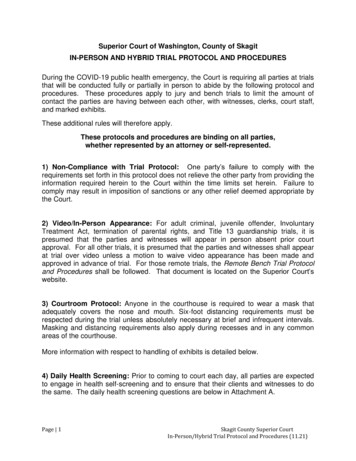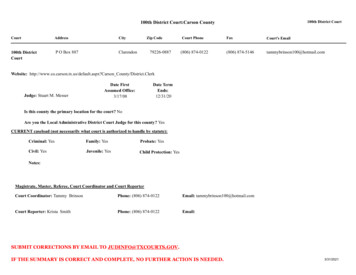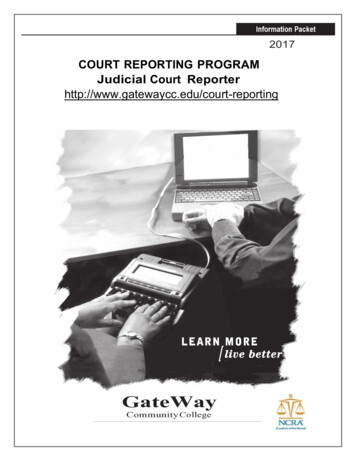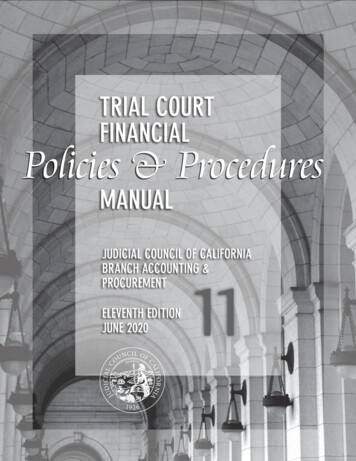
Transcription
TRIAL COURTFINANCIALPolicies & ProceduresMANUALJUDICIAL COUNCIL OF CALIFORNIABRANCH ACCOUNTING &PROCUREMENTELEVENTH EDITIONJUNE 202011
Judicial Council of CaliforniaTrial Court Financial Policies and ProceduresTo the managers and staff of California’s trial courts:The Lockyer-Isenberg Trial Court Funding Act of 1997 (Assem. Bill 233; Stats. 1997,ch. 850), relieved California’s county governments of responsibility for funding trial courtoperations, shifting that responsibility to the state.This momentous change had far-reaching effects for the trial courts, which hadpreviously relied on their respective counties for funding, operations, and administrativesupport for over 40 years. Most importantly, the shift to state funding ushered in a newera of financial stability. The trial courts are assured they will receive the resourcesneeded to provide public access to justice in their communities.AB 233 required the trial courts to assume new responsibilities for fiscal managementand to be accountable for their use of public resources. It calls for the Judicial Council ofCalifornia to:adopt appropriate rules for budget submission, budget management, andreporting of revenues and expenditures by each court. [T]he JudicialCouncil shall maintain appropriate regulations for recordkeeping andaccounting by the courts, in order to determine all moneys collected by thecourts, including filing fees, fines, forfeitures, and penalties, and allrevenues and expenditures relating to court operations.In compliance with rule 10.804 of the California Rules of Court, which requires theJudicial Council of California to adopt financial policies and procedures, this manualhas been developed to establish the financial and accounting policies for California’s58 trial courts. The manual is intended to assist the trial courts in complying withstatutory requirements and administrative policies and procedures for trial court fiscalmanagement.Between editions of the manual, Finance Memos will communicate new or enhancedfinancial policies and procedures to the trial courts. These Finance Memos will serve asinterim guidelines. They must be incorporated into your local manual and distributed tocourt personnel as appropriate.June 2020
Trial Court Financial Policies andProceduresJudicial Council of CaliforniaIntroductionPage iiThe manual sets out a system of fundamental internal controls that will enable the trialcourts to monitor their use of public funds. To provide flexibility to trial court managers,the manual does not prescribe highly detailed procedures. Rather, it defines theguidelines and boundaries within which the courts will conduct their fiscal operations.The Judicial Council of California recognizes that adhering to some of the proceduresmay not be efficient for smaller-sized courts due to reliance on county systems andpractices. In these instances, alternative procedures must be documented, incorporatedinto your local manual, and distributed to court personnel.Unless otherwise noted, alternative procedures to those included in the Trial CourtFinancial Policies and Procedures Manual or your county’s policy documents must beapproved by the Judicial Council of California. Undocumented procedures or thosenot approved by the Judicial Council of California will not be considered valid foraudit purposes.It is imperative that local trial court operations and fiscal managers review their currentpractices, policies, and procedures to be sure that they are acting within the guidelinesestablished by this manual. The Judicial Council of California is available to provideguidance and to assist the trial courts in their efforts to improve fiscal operations andincrease accountability for public funds.For ease of use, this manual is divided into sections. Each section includes policies andprocedures on specific business operations topics. A table of contents is included ineach section to aid users in locating information on specific subjects.The topics covered in this manual include: Trial Court OrganizationFiscal ManagementFund AccountingBudgetsAccounting PracticesProcurementContractsAccounts PayableFixed AssetsCollectionsAuditsRecord RetentionBanking and TreasurySecurityMiscellaneousYou are encouraged to submit suggestions for improving trial court business operations.If you have specific questions related to the manual, please send them to:Judicial Council Branch Accounting and Procurement DirectorRe: Trial Court Financial Policies and Procedures Manual2850 Gateway Oaks Drive, Suite 300Sacramento, CA 95833-4348Email: TCFin@jud.ca.gov or Robert Downs at robert.downs@jud.ca.govJune 2020
Judicial Council of CaliforniaTrial Court Financial Policies and Procedures Manual—11th Edition (2020)Section No.Policy No.Name of PolicyManual Organization and StructureMethod of CitationAssociated DocumentsUse of “Shall,” “Must,” “Will,” “May,” and “Should”Section 1FIN 1.01FIN 1.02FIN 1.03OrganizationTrial Court OrganizationResponsibilities and AuthorityInternal ControlsSection 2FIN 2.01Fiscal ManagementFinancial ManagementSection 3FIN 3.01Fund AccountingFund AccountingSection 4FIN 4.01FIN 4.02FIN 4.03BudgetsBudget DevelopmentBudget Monitoring and ReportingPosition ManagementSection 5FIN 5.01FIN 5.02FIN 5.03Accounting PracticesAccounting PrinciplesGeneral LedgerGrant Accounting and AdministrationSection 6FIN 6.01ProcurementProcurement (Trial Court Construction)Section 7FIN 7.01FIN 7.02FIN 7.03ContractsContracts (Trial Court Construction)FIN 7.02 and FIN 7.03 superseded by Judicial Branch ContractingManualJune 2020
Trial Court Financial Policies andProceduresJudicial Council of CaliforniaSection No.Policy No.Section 8FIN 8.01FIN 8.02FIN 8.03IntroductionPage ivName of PolicyFIN 8.04FIN 8.05Accounts PayableVendor Invoice ProcessingClaim ProcessingTravel Expense Reimbursement for Trial Court Judges andEmployeesPetty CashBusiness Meal Expense GuidelinesSection 9FIN 9.01Fixed AssetsFixed Asset ManagementSection 10FIN 10.01FIN 10.02CollectionsUniform Civil Fees (UCF) and Criminal and Traffic Fines and FeesCollections and DistributionCash HandlingSection 11FIN 11.01AuditsAuditsSection 12FIN 12.01Record RetentionRecord RetentionSection 13FIN 13.01Banking and TreasuryBanking ServicesSection 14FIN 14.01SecurityCourt Security [Under Revision]Section 15FIN 15.01FIN 15.02FIN 15.03FIN 15.04FIN 15.05FIN 15.06FIN 15.07FIN 15.08MiscellaneousGifts of Personal PropertyIndirect Cost Rate Proposal (ICRP)EscheatChange of VenueTrial Court Trust Fund Funds Held on Behalf of the Trial CourtsAssembly Bill 2695–Service of Process ReimbursementReimbursement of Costs Related to State PrisonsReimbursement of Extraordinary Costs Associated With HomicideTrialsReimbursement of Elder/Dependent Abuse PetitionsFIN 15.09GlossaryJune 2020
Trial Court Financial Policies andProceduresManual Organization and StructurePage vMANUAL ORGANIZATION AND STRUCTUREThe Trial Court Financial Policies and Procedures Manual is an integrated set of financialpolicies and procedures designed to promote consistency and standardization in the businesspractices of California’s trial courts.Each policy addresses a major topic that is discussed in a common structure and format, andincludes the purpose of the procedure, a policy statement, table of contents, applicationstatement, relevant key terms, and the specific guiding procedures intended to implement thepolicy topic.Structure of Financial PoliciesPolicy Title1.0Table of Contents1.0 Table of Contents2.0 Purpose3.0 Policy4.0 Application5.0 Definitions6.0 Text6.16.27.0 Associated Documents2.0PurposeThe purpose of this policy is to 3.0PolicyThe trial court shall 4.0ApplicationThis policy applies to all trial court officers and employees.5.0Definitions6.0Text6.1 Section6.1.1 Subsection1. Paragrapha. Itemi. Sub-item7.0Associated DocumentsJune 2020Back to Main TOCBack to Policy TOC
Trial Court Financial Policies andProceduresManual Organization and StructurePage viTo facilitate manual configuration and revisions, each procedure has a cover sheet that states theprocedure name and number, the effective date of the procedure, and the most recent procedurerevision date. The procedure number and title are repeated on the header of each page of themanual.This manual is organized to allow the trial courts flexibility to conduct normal operations withinthe parameters of applicable federal, state, and Judicial Council of California requirements.Particular emphasis has been placed on certain aspects of financial practices where warranted bythe subject matter.Method of CitationUsing common terminology when referring to specific parts of this manual will avoid confusionand help others find citations quickly and easily. For example, a reference to one of theorganizational requirements for handling cash would be written FIN 10.02, 6.3.2(1)(a)(i) andwould be read Policy Number FIN 10.02, subsection 6.3.2, paragraph 1, item a, sub-item i.Associated DocumentsFollowing each policy section are sample documents for court reference. Many of the associateddocuments have been developed into fillable PDF documents and can be located on the JudicialResources Network at https://jrn.courts.ca.gov/jc/tcfp/index.htm.Use of “Shall,” “Must,” “Will,” “May,” and “Should”In this manual, words recur with their intended meaning for consistency. As a result, the terms“shall” and “should” are often replaced with the term “will” when appropriate. Shall. The term “shall” is properly used only when the intended meaning is “a duty to”;for example, “According to federal law, the court shall impose the maximum sentence.”In contract and legal drafting, the term is most often replaced with the term “will,”“may,” or “should,” as appropriate. Must. The term “must” is considered inappropriately “bossy” in everyday language andmay be considered more important than other words such as “will” when both terms areused in a document. The word “will” is an appropriate replacement when it is usedconsistently throughout the document. If both words (“shall” and “will”) are used whenthe drafter intends the same level of commitment, it may be confusing and should beavoided. Will. The term “will” ought to bear a consistent meaning within a document. It mayexpress the obligations of both parties when the relationship is more or less betweenequals or it may express one party’s obligations in an adhesion contract when it is usedwith the term “must” for the other party. The term may also be used to express a futurecontingency, although this is not the common usage in modern drafting. May. The term “may” means “has discretion to” or “is permitted.” It should be the onlyterm to denote these senses.June 2020Back to Main TOC
Trial Court Financial Policies andProcedures Manual Organization and StructurePage viiShould. The term “should” denotes a direct provision.June 2020Back to Main TOC
Judicial Council of CaliforniaTrial Court Financial Policies and ProceduresTRIAL COURT ORGANIZATIONPOLICY NUMBER: FIN 1.01Revised September 2020Back to Main TOC
Trial Court Financial Policies andProceduresTrial Court OrganizationPolicy No. FIN 1.01Page 2 of 11Trial Court OrganizationTable of Contents1.02.03.04.05.06.0Table of ContentsPurposePolicy StatementApplicationDefinitionsText6.1 The Judicial Council of California6.1.16.1.26.1.3Organization of the Judicial Council of CaliforniaDuties and Responsibilities of the Judicial Council of CaliforniaRules of Court6.2 Judicial Council of California Staff6.2.16.2.2Organization of Judicial Council of California StaffDuties and Responsibilities of Judicial Council of California Staff6.3 The Trial Court6.3.16.3.2Organization of the Trial CourtDuties and Responsibilities of the Trial Court6.4 Trial Court Operating Standards7.0 Associated DocumentsPurposeThe purpose of this policy is to describe the organizational structure, duties and responsibilities,and authority of the major governmental organizations that make up or have an administrative orpolicymaking role for the State of California trial court system.Policy StatementThe Judicial Council of California is the governing body of the California court system,including the trial courts. Consistent with its constitutional authority, the requirements of theLockyer-Isenberg Trial Court Funding Act of 1997 (AB 233) and other legislation, the JudicialCouncil of California has established financial rules that allow and require the trial courts tooperate responsibly.ApplicationThis procedure applies to all trial court officials and employees.DefinitionsRefer to the Glossary for the following key term used in this policy.Lockyer-Isenberg Trial Court Funding Act of 1997 (AB 233)June 2020Back to Main TOC
Trial Court Financial Policies andProceduresTrial Court OrganizationPolicy No. FIN 1.01Page 3 of 11TextThe trial court is subject to the policies and rules established by the Judicial Council ofCalifornia and the policies and procedures established by Judicial Council of California Staff,under delegation from the Judicial Council of California, as shown in the figure below.State of California Trial Court OrganizationJUDICIAL COUNCIL OF CALIFORNIA Established 1926Policy and rule making body for the California courtsConsisting of voting and nonvoting members (judges, courtadministrators, attorneys, legislators)JUDICIAL COUNCIL OF CALIFORNIA STAFF Provides support services for the state court systemCarries out, as needed and delegated, the Judicial Council’sofficial actionsEstablishes procedures for trial court budget development,financial management, and reportingAdministers statewide funds for the benefit of the courtsTRIAL COURTS OF CALIFORNIA 6.1Located in each of California’s 58 countiesHear civil (small claims, family, probate, juvenile) and criminal(felonies, misdemeanors, infractions) casesResponsible for managing operations consistent with theConstitution, statutes, rules of court, and standards ofjudicial administrationThe Judicial Council of California6.1.1 Organization of the Judicial Council of California1. The Judicial Council of California was established in 1926 by article VI, section 6 ofthe state Constitution. The council has policy and rule-making authority over theCalifornia courts, the nation’s largest court system. The California Constitutiondirects the Judicial Council of California to make recommendations annually to theJune 2020Back to Main TOCBack to Policy TOC
Trial Court Financial Policies andProceduresTrial Court OrganizationPolicy No. FIN 1.01Page 4 of 11Governor and the Legislature and adopt rules of court administration, practice, andprocedure.2. The Judicial Council of California operates by adopting rules, policies, andprocedures. The rule-making authority is constitutionally derived. The policy andprocedure– making authority stems primarily from statute. The council alsoestablishes advisory committees and task forces to assist it in its decision making.3. The Judicial Council of California is composed of the following members:a. The Chief Justice, who chairs the Judicial Council of California;b. One other Supreme Court justice;c. Three justices from the courts of appeal;d. Ten trial court judges;e. Four attorneys appointed by the State Bar’s governing body;f. One member from each house of the Legislature;g. Two nonvoting court administrators; andh. Any other nonvoting members as determined by the voting membership of thecouncil.6.1.2 Duties and Responsibilities of the Judicial Council of CaliforniaThe Judicial Council of California’s duties and responsibilities are defined by the stateConstitution and by statute. With respect to the operation and fiscal management of thetrial courts, the Judicial Council of California has the responsibility and authority to:1. Adopt a budget and allocate funding for the trial courts;12. Adopt policies and procedures governing practices and procedures for budgeting inthe trial courts;21Gov. Code, § 68502.5(c).2Gov. Code, § 77202(c)(1).June 2020Back to Main TOCBack to Policy TOC
Trial Court Financial Policies andProceduresTrial Court OrganizationPolicy No. FIN 1.01Page 5 of 113. In consultation with the State Controller, must maintain appropriate regulations forrecordkeeping and accounting by the courts;34. Adopt rules ensuring that, upon written request, the trial courts provide, in a timelymanner, information relating to the administration of the courts, including financialinformation;45. Prepare budget requests for the courts and oversee the allocation and management ofthe court system’s budget;56. Allocate resources in a manner that enables the trial courts to carry out theirfunctions, and promote the implementation of statewide policies, efficiencies, andcost-saving measures in court operations;67. Adopt a schedule for allocating funds to individual trial courts;78. Provide for uniform entry, storage, and retrieval of court data relating to civil casesand court administration;89. Promulgate rules for the establishment of efficient trial court management;9 and10. Regulate the budget and fiscal management of the trial courts.6.1.3 Rules of Court1. Under Article VI, section 6 of the Constitution of California, the Judicial Council ofCalifornia is charged with improving the administration of justice. The JudicialCouncil of California has constitutional authority to “adopt rules for courtadministration [and] practice and procedure. The rules adopted shall not beinconsistent with statute.” California Rules of Court have the force of law.2. The state Legislature can also have the Judicial Council of California perform otherfunctions as prescribed by statute.3Gov. Code, § 77206(a).4Gov. Code, § 77206(f).5Gov. Code, § 68502.5.6Gov. Code, § 68502.5(c).7Gov. Code, § 68502.5(a)(4).8Gov. Code, § 68513.9Gov. Code, § 77206(a).June 2020Back to Main TOCBack to Policy TOC
Trial Court Financial Policies andProceduresTrial Court OrganizationPolicy No. FIN 1.01Page 6 of 113. The Judicial Council of California’s Standards of Judicial Administration containsrecommendations for court practices and procedures. The standards provideguidelines and include goals that courts and judges are urged to attain.6.2Judicial Council of California Staff6.2.1 Organization of Judicial Council of California Staff1. Judicial Council of California Staff is the staff agency to the Judicial Council andcarries out its official actions and other functions delegated by the Judicial Council orthe Chief Justice.2. The Judicial Council of California’s mission is to serve the courts for the benefit ofall Californians by advancing excellence, leadership, and service in the administrationof justice.3. The Judicial Council of California Staff organization’s authority to develop andimplement management and administrative programs, rules, policies, and proceduresis delegated by the Judicial Council of California, which also sets guidelines forJudicial Council of California Staff to operate within.4. The Judicial Council of California Staff organization is led by the AdministrativeDirector, who is responsible for:a. Implementing the directives of the Judicial Council of California.b. Developing policies and procedures for the creation and implementation of ayearly budget for the judiciary.c. Presenting the judiciary’s budget in negotiations with the Governor and theLegislature.d. Ensuring that the fiscal affairs of the trial courts are managed efficiently,effectively, and responsibly.105. The Judicial Council of California Director of Budget Services, under the direction ofthe Administrative Director, administers the budget policies and proceduresdeveloped by the Administrative Director and approved by the Judicial Council ofCalifornia. The Judicial Council of California Director of Budget Services:10Gov. Code, § 77206(a).June 2020Back to Main TOCBack to Policy TOC
Trial Court Financial Policies andProceduresTrial Court OrganizationPolicy No. FIN 1.01Page 7 of 11a. Develops and administers the budget preparation process and ensures thesubmission of a final budget recommendation for the judiciary to the Departmentof Finance each year.b. Develops a manual of procedures for the budget request process, revenues,expenditures, allocations, and payments.c. Monitors all revenues and expenditures for the judiciary.d. Develops recommendations for fiscal priorities and the allocation and reallocationof funds.e. Assists the courts and the Administrative Director in preparing and managingbudgets.6. Judicial Council of California Budget Services provides an integrated program ofbudget planning to the judicial branch.6.2.2 Duties and Responsibilities of Judicial Council of California Staff1. The primary responsibility of Judicial Council of California Staff is to carry out thedirectives of the Judicial Council of California. With respect to the fiscal managementof the trial courts, Judicial Council of California Staff has been granted the authorityto:a. Establish budget procedures and an annual schedule of budget development andmanagement consistent with Judicial Council of California rules.b. Set forth the criteria for the Judicial Council of California’s trial court budgetrequest.c. Administer the State Trial Court Improvement and Modernization Fund alongguidelines set by the Judicial Council of California.6.3The Trial Court6.3.1 Organization of the Trial Court1. Trial courts are located in each of California’s 58 counties.2. The trial court organization structure is as follows:a. Each trial court is headed by a presiding judge, who is ultimately responsible forall the administrative actions of the court.June 2020Back to Main TOCBack to Policy TOC
Trial Court Financial Policies andProceduresTrial Court OrganizationPolicy No. FIN 1.01Page 8 of 11b. The court executive officer, who reports directly to the presiding judge, isresponsible for the management and administration of court operations.c. The trial court may also employ a court fiscal officer, who is responsible for thedetailed management of the court’s financial and accounting functions.d. The trial court operations are typically organized based on the programs that thecourts conduct within the county that they reside in. Examples of court programsare General Civil, Family Law, Probate, Small Claims, Traffic, Criminal,Juvenile, and miscellaneous programs.e. The trial court shall prepare an organizational chart that should be updated at leastonce per year.6.3.2 Duties and Responsibilities of the Trial Court1. Under Government Code section 77001, the Judicial Council of California is requiredto “adopt rules which establish a decentralized system of trial court management”including:a. Local authority and responsibility of the trial courts to manage day-to-dayoperations.b. Countywide administration of the trial courts.c. The authority and responsibility of the trial courts to manage all of the following,consistent with statute, rules of court, and standards of judicial administration:i. Annual allocation of funding, including policies and procedures aboutmoving funding between functions or line items or programs.ii. Local personnel plans, including the promulgation of personnel policies.iii. Processes and procedures to improve court operations and responsiveness tothe public.iv. The trial courts of each county shall establish the means of selectingpresiding judges, assistant presiding judges, executive officers or courtadministrators, clerks of court, and jury commissioners.d. Trial court input to the Judicial Council of California budget process.e. Equal access to justice throughout California utilizing standard practices andprocedures whenever feasible.June 2020Back to Main TOCBack to Policy TOC
Trial Court Financial Policies andProcedures6.4Trial Court OrganizationPolicy No. FIN 1.01Page 9 of 11Trial Court Operating Standards1. The Director of Branch Accounting and Procurement of the Judicial Council ofCalifornia, under the direction of the Administrative Director, periodically updates thismanual for use by the trial courts.a. This manual is intended to assist the trial courts in complying with statutoryrequirements, rules of court, and various industry and professional standards.b. Between editions of the manual, Finance Memos may be issued by the Director ofBranch Accounting and Procurement and/or the Director of Budget Services tomodify, adopt, or repeal financial policies or procedures as appropriate. TheseFinance Memos are interim policies and procedures and are considered adopted asinterim amendments to this manual immediately upon expiration of the 30-daycomment period outlined in rule 10.804(b)(1) of the California Rules of Court unlessmodified within that period. Under rule 10.804(c), superior courts must adhere tothese changes within 60 days after adoption of the amendment. This manualsupersedes all Finance Memos dated before the current manual revision date, unlessspecifically noted in the Finance Memo. On rare occasions, a Finance Memo mayneed to be issued while manual updates are in the final review and approval process.2. The trial court shall manage its operations within the limits established by the JudicialCouncil of California’s policies, procedures, rules, and programs prepared and adoptedby Judicial Council of California Staff.a. The trial courts must develop processes to guide staff in the implementation of thepolicies and procedures contained in this manual, or to perform particular procedureswith limited supervision. Local policies and procedures developed and used by thetrial court will be documented, incorporated into the local trial court manual, anddistributed to court personnel. Local policies and procedures can incorporate portionsof this manual and can be worded differently provided the policies and procedures areconsistent with the policies and procedures contained in this manual.b. To the extent that the trial court continues to rely on county processes, the trial courtcan continue to follow local county policies and procedures as long as they areconsistent with the policies and procedures in this manual.3. A presiding judge or his or her designee who wants to establish an alternative procedurewill submit a signed and dated Request for Alternative Procedure (RAP) form (copyprovided in 7.0, Associated Documents) to:Judicial Council of CaliforniaDirector of Branch Accounting and ProcurementAttn.: Trial Court Alternative Financial Policies and ProceduresJune 2020Back to Main TOCBack to Policy TOC
Trial Court Financial Policies andProceduresTrial Court OrganizationPolicy No. FIN 1.01Page 10 of 112850 Gateway Oaks Drive, Suite 300Sacramento, CA 95833-4348Email: TCFin@jud.ca.govA written response to the submission of alternative procedures will be returned to thesubmitting court within 60 business days of receipt of the document. When a Request forAlternative Procedure has been received by Judicial Council of California Staff, anacknowledgment of receipt will be returned to the submitting court. The 60-business-dayresponse time will begin once the court receives that acknowledgment of receipt. Absenta response from Judicial Council of California Staff within 60 business days, thealternative procedure will be in effect, subject to further review and consideration byJudicial Council of California Staff. Undocumented procedures or those notapproved by Judicial Council of California Staff will not be considered valid foraudit purposes.Once approved, alternative procedures must be documented by the trial court, incorporatedinto the local trial court manual, and distributed to court personnel. Any alternativeprocedure that is different from what is included in the Trial Court Financial Policies andProcedures Manual or the county’s policy document must first be approved by JudicialCouncil of California Staff.Associated DocumentsRequest for Alternative Procedure (RAP) FormJune 2020Back to Main TOCBack to Policy TOC
Trial Court Financial Policies andProceduresTrial Court OrganizationPolicy No. FIN 1.01Page 11 of 11Request for Alternative Procedure—Superior CourtRequestor InformationSuperior Court:Name:Title:Date Received by Judicial Council of California Staff:Regarding Judicial Council of California Policy No. FIN #.0#:1. Extract from current Trial Court Financial Policies and Procedures Manual regardingrequested alternative procedure.2. Describe in detail the reason(s) for the alternative procedure and include proposedalternative procedure text.Name and Title, Superior Court ofDateJudicial Council of California Staff Evaluation of RequestAccepted or Not AcceptedJudicial Council of California StaffDateJune 2020Back to Main TOCBack to Policy TOC
Judicial Council of CaliforniaTrial Court Financial Policies and ProceduresRESPONSIBILITIES AND AUTHORITYPOLICY NUMBER: FIN 1.02Revised June 2020Back to Main TOC
Trial Court Financial Policies andProceduresResponsibilities and AuthorityPolicy No. FIN 1.02Page 2 of 5Responsibilities and Authority1.0 Table of Contents1.02.03.04.05.06.0Table of ContentsPurposePolicy StatementApplicationDefinitionsText6.1 Governance and Accountability6.2 Responsibilities6.3 Duties7.0 Associated DocumentsPurposeThe purpose of this policy is to establish the general responsibilities and authorities of trial courtjudges, subordinate judicial officers, management, supervisors, and staff with regard to thefinancial operations of the court and the preparation of internal and external financial reports.Policy StatementThe trial court is subject to the rules and policies established by the Judicial Council ofCalifornia or its staff under its delegation to promote efficiency and uniformity within a systemof trial court management. Within the boundaries established by the Judicial Council ofCalifornia, each trial court has the authority and is responsible for managing its own operations.All employees are expected to fulfill at least the minimum requirements of their positions and toconduct
into your local manual, and distributed to court personnel. Unless otherwise noted, alternative procedures to those included in the . Trial Court Financial Policies and Procedures Manual. or your county's policy documents must be approved by the Judicial Council of California. Undocumented procedures or those

